New Notes
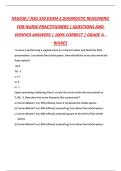
NSG550 / NSG 550 Exam 2 (Latest 2025 / 2026 Update): Diagnostic Reasoning for Nurse Practitioners, 100% Verified Graded A+ Ace your NSG550 Exam 2 in Diagnostic Reasoning for Nurse Practitioners with this fully updated PDF study guide. Designed for graduate nursing students, this guide condenses all key concepts, clinical reasoning strategies, and high-yield exam content into a convenient, instant downloadable format. Includes practice questions, verified A+ answers, and proven test strategies,...
- Exam (elaborations)
- • 26 pages •
NSG550 / NSG 550 Exam 2 (Latest 2025 / 2026 Update): Diagnostic Reasoning for Nurse Practitioners, 100% Verified Graded A+ Ace your NSG550 Exam 2 in Diagnostic Reasoning for Nurse Practitioners with this fully updated PDF study guide. Designed for graduate nursing students, this guide condenses all key concepts, clinical reasoning strategies, and high-yield exam content into a convenient, instant downloadable format. Includes practice questions, verified A+ answers, and proven test strategies,...
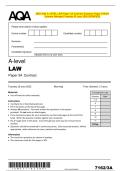
2025 AQA A-LEVEL LAW Paper 3A Contract Question Paper & Mark Scheme (Merged) Tuesday 10 June 2025 [VERIFIED] 2 Do not write outside the IB/G/Jun25/7162/3A Answer all questions in the spaces provided. box Select the false statement about remedies for misrepresentation in contract. [1 mark] A For fraudulent misrepresentation, the remedies are rescission and damages. B For fraudulent misrepresentation, the remedy of rescission may not be awarded ...
- Exam (elaborations)
- • 41 pages •
2025 AQA A-LEVEL LAW Paper 3A Contract Question Paper & Mark Scheme (Merged) Tuesday 10 June 2025 [VERIFIED] 2 Do not write outside the IB/G/Jun25/7162/3A Answer all questions in the spaces provided. box Select the false statement about remedies for misrepresentation in contract. [1 mark] A For fraudulent misrepresentation, the remedies are rescission and damages. B For fraudulent misrepresentation, the remedy of rescission may not be awarded ...
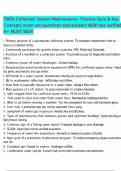
CWEA Collection System Maintenance- Practice Quiz & Key Concepts exam set questions and answers NEW tips verified A+ MUST SEE!!!.pdf CWEA Collection System Maintenance- Practice Quiz & Key Concepts exam set questions and answers NEW tips verified A+ MUST SEE!!!.pdf CWEA Collection System Maintenance- Practice Quiz & Key Concepts exam set questions and answers NEW tips verified A+ MUST SEE!!!.pdf
- Exam (elaborations)
- • 6 pages •
CWEA Collection System Maintenance- Practice Quiz & Key Concepts exam set questions and answers NEW tips verified A+ MUST SEE!!!.pdf CWEA Collection System Maintenance- Practice Quiz & Key Concepts exam set questions and answers NEW tips verified A+ MUST SEE!!!.pdf CWEA Collection System Maintenance- Practice Quiz & Key Concepts exam set questions and answers NEW tips verified A+ MUST SEE!!!.pdf
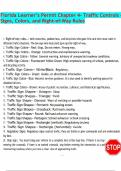
Florida Learner’s Permit Chapter 4- Traffic Controls – Signs, Colors, and Right-of-Way R Florida Learner’s Permit Chapter 4- Traffic Controls – Signs, Colors, and Right-of-Way R Florida Learner’s Permit Chapter 4- Traffic Controls – Signs, Colors, and Right-of-Way R
- Exam (elaborations)
- • 16 pages •
Florida Learner’s Permit Chapter 4- Traffic Controls – Signs, Colors, and Right-of-Way R Florida Learner’s Permit Chapter 4- Traffic Controls – Signs, Colors, and Right-of-Way R Florida Learner’s Permit Chapter 4- Traffic Controls – Signs, Colors, and Right-of-Way R
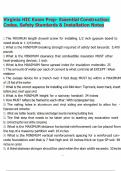
Virginia HIC Exam Prep- Essential Construction Codes, Safety Standards & Installation N Virginia HIC Exam Prep- Essential Construction Codes, Safety Standards & Installation N Virginia HIC Exam Prep- Essential Construction Codes, Safety Standards & Installation N
- Exam (elaborations)
- • 5 pages •
Virginia HIC Exam Prep- Essential Construction Codes, Safety Standards & Installation N Virginia HIC Exam Prep- Essential Construction Codes, Safety Standards & Installation N Virginia HIC Exam Prep- Essential Construction Codes, Safety Standards & Installation N
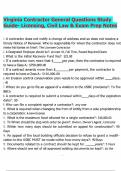
Virginia Contractor General Questions Study Guide- Licensing, Civil Law & Exam Prep N Virginia Contractor General Questions Study Guide- Licensing, Civil Law & Exam Prep N Virginia Contractor General Questions Study Guide- Licensing, Civil Law & Exam Prep N
- Exam (elaborations)
- • 5 pages •
Virginia Contractor General Questions Study Guide- Licensing, Civil Law & Exam Prep N Virginia Contractor General Questions Study Guide- Licensing, Civil Law & Exam Prep N Virginia Contractor General Questions Study Guide- Licensing, Civil Law & Exam Prep N

Virginia Contractor Exam Study Guide 2025 – Construction, Safety, and Building Code Practice Questions with Correct Answers (Updated PDF).pdf Virginia Contractor Exam Study Guide 2025 – Construction, Safety, and Building Code Practice Questions with Correct Answers (Updated PDF).pdf Virginia Contractor Exam Study Guide 2025 – Construction, Safety, and Building Code Practice Questions with Correct Answers (Updated PDF).pdf
- Exam (elaborations)
- • 9 pages •
Virginia Contractor Exam Study Guide 2025 – Construction, Safety, and Building Code Practice Questions with Correct Answers (Updated PDF).pdf Virginia Contractor Exam Study Guide 2025 – Construction, Safety, and Building Code Practice Questions with Correct Answers (Updated PDF).pdf Virginia Contractor Exam Study Guide 2025 – Construction, Safety, and Building Code Practice Questions with Correct Answers (Updated PDF).pdf
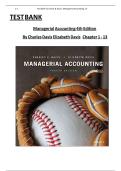
TEST BANK FOR Managerial Accounting 4th Edition by Charles E. Davis, Elizabeth Davis ISBN: 978-1119577669 COMPLETE GUIDE ALL CHAPTERS COVERED 100% VERIFIED A+ GRADE ASSURED!!!!NEW LATEST UPDATE!!!GUARANTEED PASS!!!!
- Book
- Exam (elaborations)
- • 902 pages •
TEST BANK FOR Managerial Accounting 4th Edition by Charles E. Davis, Elizabeth Davis ISBN: 978-1119577669 COMPLETE GUIDE ALL CHAPTERS COVERED 100% VERIFIED A+ GRADE ASSURED!!!!NEW LATEST UPDATE!!!GUARANTEED PASS!!!!
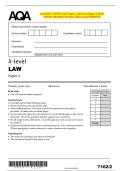
2025 AQA A-LEVEL LAW Paper 2 Question Paper & Mark Scheme (Merged) Tuesday 3 June 2025 [VERIFIED] 2 Do not write outside the IB/G/Jun25/7162/2 Answer all questions in the spaces provided. box In relation to the Occupiers’ Liability Act 1957, which of the following statements is false? [1 mark] A The defendant can be liable for damage to the claimant’s property. B The defendant can use the defence of contributory negligence. C The defen...
- Exam (elaborations)
- • 34 pages •
2025 AQA A-LEVEL LAW Paper 2 Question Paper & Mark Scheme (Merged) Tuesday 3 June 2025 [VERIFIED] 2 Do not write outside the IB/G/Jun25/7162/2 Answer all questions in the spaces provided. box In relation to the Occupiers’ Liability Act 1957, which of the following statements is false? [1 mark] A The defendant can be liable for damage to the claimant’s property. B The defendant can use the defence of contributory negligence. C The defen...
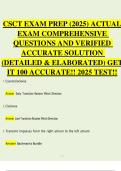
This document is a comprehensive CSCT Exam Prep 2025 study resource containing actual exam-style questions with verified, accurate, and detailed solutions, specifically designed for candidates preparing for the Certified Stress Testing Technician certification. It thoroughly covers core cardiovascular concepts tested on the CSCT exam, including cardiac anatomy and physiology, coronary circulation, autonomic nervous system regulation, hemodynamics, blood pressure dynamics, and myocardial oxygen d...
- Exam (elaborations)
- • 78 pages •
This document is a comprehensive CSCT Exam Prep 2025 study resource containing actual exam-style questions with verified, accurate, and detailed solutions, specifically designed for candidates preparing for the Certified Stress Testing Technician certification. It thoroughly covers core cardiovascular concepts tested on the CSCT exam, including cardiac anatomy and physiology, coronary circulation, autonomic nervous system regulation, hemodynamics, blood pressure dynamics, and myocardial oxygen d...
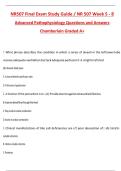
NR507 Final Exam Study Guide 2026 | Weeks 5-8 Advanced Pathophysiology | Questions and Guide Answers (Latest 2025/2026 Update) Graded A- Chamberlain Ace your NR507 Final Exam (Weeks 5–8) with this ultimate Advanced Pathophysiology study guide PDF. Designed for graduate nursing students, this guide condenses complex concepts into a high-yield, exam-focused format, helping you efficiently master all essential topics. From cellular function and disease mechanisms to clinical applications, this ...
- Package deal
- Exam (elaborations)
- • 85 pages •
NR507 Final Exam Study Guide 2026 | Weeks 5-8 Advanced Pathophysiology | Questions and Guide Answers (Latest 2025/2026 Update) Graded A- Chamberlain Ace your NR507 Final Exam (Weeks 5–8) with this ultimate Advanced Pathophysiology study guide PDF. Designed for graduate nursing students, this guide condenses complex concepts into a high-yield, exam-focused format, helping you efficiently master all essential topics. From cellular function and disease mechanisms to clinical applications, this ...
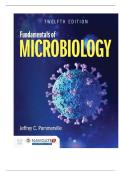
TEST BANK FOR Fundamentals of Microbiology 12th Edition by Jeffrey C. Pommerville ISBN: 978-1284211757 COMPLETE GUIDE ALL CHAPTERS COVERED 100% VERIFIED A+ GRADE ASSURED!!!!NEW LATEST UPDATE!!!!GUARANTEED PASS!!!
- Book
- Exam (elaborations)
- • 742 pages •
TEST BANK FOR Fundamentals of Microbiology 12th Edition by Jeffrey C. Pommerville ISBN: 978-1284211757 COMPLETE GUIDE ALL CHAPTERS COVERED 100% VERIFIED A+ GRADE ASSURED!!!!NEW LATEST UPDATE!!!!GUARANTEED PASS!!!
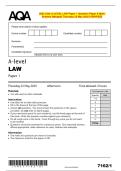
2025 AQA A-LEVEL LAW Paper 1 Question Paper & Mark Scheme (Merged) Thursday 22 May 2025 [VERIFIED] 2 Do not write outside the IB/G/Jun25/7162/1 Answer all questions in the spaces provided. box In relation to the offence of unlawful act (constructive) manslaughter, which one of the following statements about the ‘dangerousness’ requirement is true? [1 mark] A The defendant must foresee a risk of death. B The defendant must foresee the risk...
- Exam (elaborations)
- • 30 pages •
2025 AQA A-LEVEL LAW Paper 1 Question Paper & Mark Scheme (Merged) Thursday 22 May 2025 [VERIFIED] 2 Do not write outside the IB/G/Jun25/7162/1 Answer all questions in the spaces provided. box In relation to the offence of unlawful act (constructive) manslaughter, which one of the following statements about the ‘dangerousness’ requirement is true? [1 mark] A The defendant must foresee a risk of death. B The defendant must foresee the risk...
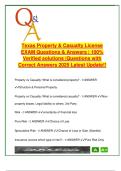
This comprehensive exam resource contains over 250 verified questions and answers for the Texas Property and Casualty Insurance Licensing Exam, fully updated for the 2025–2026 testing cycle. The material is aligned with the Texas Department of Insurance (TDI) requirements and covers all essential areas tested on the state licensing exam for insurance producers. The guide offers detailed coverage of both personal and commercial lines, including homeowners, auto, liability, endorsements, clai...
- Exam (elaborations)
- • 19 pages •
This comprehensive exam resource contains over 250 verified questions and answers for the Texas Property and Casualty Insurance Licensing Exam, fully updated for the 2025–2026 testing cycle. The material is aligned with the Texas Department of Insurance (TDI) requirements and covers all essential areas tested on the state licensing exam for insurance producers. The guide offers detailed coverage of both personal and commercial lines, including homeowners, auto, liability, endorsements, clai...
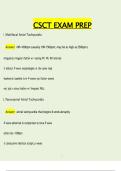
This document is a comprehensive CSCT exam preparation study guide, designed to support candidates preparing for the Certified Stress Testing Technician (CSCT) certification exam. It provides detailed explanations and exam-focused summaries of a wide range of cardiovascular topics essential for stress testing professionals. The material includes clear identification and differentiation of atrial, junctional, and supraventricular dysrhythmias, ECG interpretation principles, special rhythm pattern...
- Exam (elaborations)
- • 19 pages •
This document is a comprehensive CSCT exam preparation study guide, designed to support candidates preparing for the Certified Stress Testing Technician (CSCT) certification exam. It provides detailed explanations and exam-focused summaries of a wide range of cardiovascular topics essential for stress testing professionals. The material includes clear identification and differentiation of atrial, junctional, and supraventricular dysrhythmias, ECG interpretation principles, special rhythm pattern...
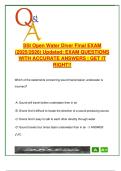
This final exam prep guide contains 60+ updated and verified multiple-choice questions with correct answers, aligned with the SSI Open Water Diver certification standards for 2025–2026. It is specifically designed to help students and trainee divers review and reinforce essential concepts in scuba diving, including physics, physiology, dive planning, equipment use, and emergency procedures. The questions are modeled after real SSI final exam formats and provide clear, practical reasoning behin...
- Exam (elaborations)
- • 18 pages •
This final exam prep guide contains 60+ updated and verified multiple-choice questions with correct answers, aligned with the SSI Open Water Diver certification standards for 2025–2026. It is specifically designed to help students and trainee divers review and reinforce essential concepts in scuba diving, including physics, physiology, dive planning, equipment use, and emergency procedures. The questions are modeled after real SSI final exam formats and provide clear, practical reasoning behin...

NR507/ NR 507 Midterm Exam Advanced Pathophysiology (Latest 2025/2026 Update) Complete Questions and Guide Answers, 100% Verified Graded A+ Prepare to ace your NR507 Midterm Exam in Advanced Pathophysiology with this ultimate study guide PDF. Designed for graduate nursing students, this guide condenses complex topics into a high-yield, exam-focused format, making studying faster, smarter, and more effective. Included are practice questions, detailed explanations, and proven test strategies to ...
- Package deal
- Exam (elaborations)
- • 19 pages •
NR507/ NR 507 Midterm Exam Advanced Pathophysiology (Latest 2025/2026 Update) Complete Questions and Guide Answers, 100% Verified Graded A+ Prepare to ace your NR507 Midterm Exam in Advanced Pathophysiology with this ultimate study guide PDF. Designed for graduate nursing students, this guide condenses complex topics into a high-yield, exam-focused format, making studying faster, smarter, and more effective. Included are practice questions, detailed explanations, and proven test strategies to ...
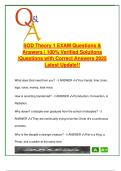
This in-depth exam resource presents over 100 fully verified questions and answers based on SOD (School of Disciples) Theory 1, offering theological and doctrinal insight for students engaged in early Christian ministry training. Updated for the 2025–2026 academic year, it comprehensively covers topics such as discipleship identity, spiritual warfare, demonic operations, divine attributes, and scriptural applications. The document is formatted as a Q&A guide, ideal for preparing for written...
- Exam (elaborations)
- • 20 pages •
This in-depth exam resource presents over 100 fully verified questions and answers based on SOD (School of Disciples) Theory 1, offering theological and doctrinal insight for students engaged in early Christian ministry training. Updated for the 2025–2026 academic year, it comprehensively covers topics such as discipleship identity, spiritual warfare, demonic operations, divine attributes, and scriptural applications. The document is formatted as a Q&A guide, ideal for preparing for written...
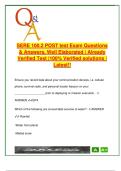
This document includes 60+ thoroughly verified and well-explained multiple-choice and true/false questions and answers based on the SERE 100.2 Post-Test—Survival, Evasion, Resistance, and Escape. Fully aligned with the 2025–2026 military training cycle, it is essential for service members preparing to certify or recertify in SERE compliance, particularly those deploying to high-risk environments. The content covers real-world application of U.S. military doctrine and Code of Conduct artic...
- Exam (elaborations)
- • 7 pages •
This document includes 60+ thoroughly verified and well-explained multiple-choice and true/false questions and answers based on the SERE 100.2 Post-Test—Survival, Evasion, Resistance, and Escape. Fully aligned with the 2025–2026 military training cycle, it is essential for service members preparing to certify or recertify in SERE compliance, particularly those deploying to high-risk environments. The content covers real-world application of U.S. military doctrine and Code of Conduct artic...

This complete exam preparation guide features 100+ multiple-choice and true/false questions with accurate answers, aligned with the SafeStaff Food Handler Certificate Test, fully updated for the 2025–2026 compliance cycle. Designed to meet the Florida Department of Health’s food safety training requirements, the document comprehensively covers all key knowledge areas for food handlers, including time-temperature control, personal hygiene, cross-contamination, cleaning protocols, and pest pre...
- Exam (elaborations)
- • 12 pages •
This complete exam preparation guide features 100+ multiple-choice and true/false questions with accurate answers, aligned with the SafeStaff Food Handler Certificate Test, fully updated for the 2025–2026 compliance cycle. Designed to meet the Florida Department of Health’s food safety training requirements, the document comprehensively covers all key knowledge areas for food handlers, including time-temperature control, personal hygiene, cross-contamination, cleaning protocols, and pest pre...
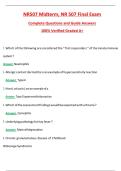
NR507 Midterm & Final Exam | Advanced Pathophysiology (Latest 2025/2026 Update) Complete Questions and Guide Answers, 100% Verified Graded A+ Dominate your NR507 Advanced Pathophysiology exams with this all-in-one Midterm & Final Exam PDF study guide. Perfect for graduate nursing students, this guide condenses critical content into a high-yield, exam-focused format, making it easier than ever to master complex pathophysiology concepts. Prepare with confidence and boost your score using targete...
- Package deal
- Exam (elaborations)
- • 60 pages •
NR507 Midterm & Final Exam | Advanced Pathophysiology (Latest 2025/2026 Update) Complete Questions and Guide Answers, 100% Verified Graded A+ Dominate your NR507 Advanced Pathophysiology exams with this all-in-one Midterm & Final Exam PDF study guide. Perfect for graduate nursing students, this guide condenses critical content into a high-yield, exam-focused format, making it easier than ever to master complex pathophysiology concepts. Prepare with confidence and boost your score using targete...
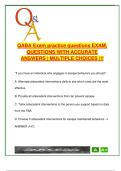
This exam-focused resource includes over 200 practice questions and answers specifically designed for the Qualified Applied Behavior Analysis Credentialing Board (QABA) certification exams, including the ABAT (Applied Behavior Analysis Technician) and QASP-S (Qualified Autism Services Practitioner – Supervisor) levels. Fully updated for 2025–2026, the document mirrors QABA’s latest exam domains and ethical guidelines, preparing candidates for both theoretical knowledge and applied clinical...
- Exam (elaborations)
- • 59 pages •
This exam-focused resource includes over 200 practice questions and answers specifically designed for the Qualified Applied Behavior Analysis Credentialing Board (QABA) certification exams, including the ABAT (Applied Behavior Analysis Technician) and QASP-S (Qualified Autism Services Practitioner – Supervisor) levels. Fully updated for 2025–2026, the document mirrors QABA’s latest exam domains and ethical guidelines, preparing candidates for both theoretical knowledge and applied clinical...
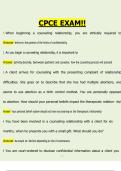
This document is a comprehensive and fully solved CPCE (Counselor Preparation Comprehensive Examination) practice exam, designed to support graduate-level counseling students preparing for the CPCE and related comprehensive or exit examinations. It includes an extensive set of exam-style questions with correct answers covering all major CACREP-aligned content areas, such as professional ethics and legal issues, counseling theories, human growth and development, multicultural counseling, group co...
- Exam (elaborations)
- • 52 pages •
This document is a comprehensive and fully solved CPCE (Counselor Preparation Comprehensive Examination) practice exam, designed to support graduate-level counseling students preparing for the CPCE and related comprehensive or exit examinations. It includes an extensive set of exam-style questions with correct answers covering all major CACREP-aligned content areas, such as professional ethics and legal issues, counseling theories, human growth and development, multicultural counseling, group co...
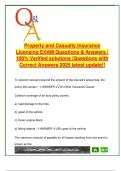
This comprehensive study guide includes over 250 verified multiple-choice questions and answers tailored for the 2025–2026 Property and Casualty Insurance Licensing Exam. Fully aligned with current licensing requirements and national/state testing formats, the content provides in-depth review material across the full scope of personal and commercial lines of property and casualty insurance. Each question is paired with a correct answer and focuses on real-world insurance applications, key l...
- Exam (elaborations)
- • 27 pages •
This comprehensive study guide includes over 250 verified multiple-choice questions and answers tailored for the 2025–2026 Property and Casualty Insurance Licensing Exam. Fully aligned with current licensing requirements and national/state testing formats, the content provides in-depth review material across the full scope of personal and commercial lines of property and casualty insurance. Each question is paired with a correct answer and focuses on real-world insurance applications, key l...
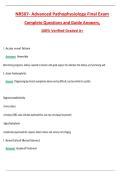
NR507 – Advanced Pathophysiology Final Exam (Latest 2025/2026 Update) Complete Questions and Guide Answers, 100% Verified Graded A+ Ace your NR507 Advanced Pathophysiology Final Exam with this ultimate study guide PDF! Designed for nursing students aiming for top scores, this comprehensive guide covers all core topics, key concepts, and practice questions you need for exam success. NR507 study guide, Advanced Pathophysiology exam PDF, NR507 final exam prep, nursing pathophysiology review, in...
- Package deal
- Exam (elaborations)
- • 21 pages •
NR507 – Advanced Pathophysiology Final Exam (Latest 2025/2026 Update) Complete Questions and Guide Answers, 100% Verified Graded A+ Ace your NR507 Advanced Pathophysiology Final Exam with this ultimate study guide PDF! Designed for nursing students aiming for top scores, this comprehensive guide covers all core topics, key concepts, and practice questions you need for exam success. NR507 study guide, Advanced Pathophysiology exam PDF, NR507 final exam prep, nursing pathophysiology review, in...
